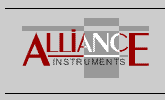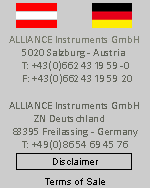| |
Products
Our
product is the automation of chemical analysis procedures
and the instrument we apply for it.
The
reduction of analysis
costs,
while
keeping the quality of analysis results, is a central
criterion for the profitability of today's laboratories.
Beside detection limits and quality management, the sample
throughput, the demand for labour and the instrument maintenance
play an important role in the decision process to apply
any analysis technique. Automatic chemical analysers provide:
•
Five-times the sample throughput in comparison to chromatographic
methods
•
Small expenses for chemicals, only a fraction of manual
method demand is required. Consequently small chemical
waste results
•
The instrument operation requires no specialist but
only trained lab assistants, the automatic analyser
saves the stable quality of the determination procedure.
•
Important steps of sample preparation are integrated
on the analyser. Automatic distillation, UV digestion,
dialysis, extraction or integrated dilution save plenty
of time.
Detail
information about the analysis task is preliminary
condition to find the recommendable technical solution.
Just the implementation of the objectives makes our automation
project competitive and economically interesting.
Existing installations may be helpful for the
decision of newcomers in automated chemical analysis.
|
View
| Technique |
Concept,
Application |
Specific
Advantages |
|
|
•
Specific method on each analysis manifold
•
typical 3-4 module / methods
•
Expandable up to 12 simultaneous analytical methods
•
Usually applied for higher sample throughput and limited
number of methods to be automatised |
•
Unbeatable analysis capacity by simultaneous determination
of all applicated methods
• Unique possibility of quality diagnosis, resulting
from the use of the segmented flow technique
• High intensity, high repeatable mixing of reaction
solutions in each stages of the automated procedure
• Complicated and individual sample preparation and reaction
procedures can be applied on the analytic manifold
• Outstanding small running costs, using standard laboratory
reagents
•
Countless number of available and approved methods, resulting
from worldwide use of CFA over decades |
|
|
•
Free selection of analysis methods to
be measured on each sample of an analysis execution
•
Very compact with integrated autosampler and computer
•
Usually applied for high analysis capacity for single methods,
or for several analysis methods on smaller sample sets |
•
Outstanding overall repeatability (dilution, sample / reagent
transfer, reaction intervals, detection)
• Special "Differential Methods" offer compensation
of individual sample colour
• Extremly small demand of sample / reagent, depending
on the method and measuring range
• High flexibility, access to method specificatons for
adaption
• Simple and safe instrument operation and maintenance
• Integrated self test and operation control
• Excellent relation of cost to performance |
|
|
•
Single parameter or multi parameter (2/4/6)
laboratory analyser
•
Single parameter or multi parameter
(2-4) online analyser
•
Single parameter or multi parameter
(2-4) nutrients-probe »submergible«
•
Sequential analysis or ISE |
•
Unbeatable sensitivity and stability, thanks to patented LFA
technique
• Hermetically close analysis loop
• Compensation of individual sample colour
• Complicated and individual sample
preparation and reaction procedures can be applied on
the analyser
• Extremely small reagent demand and energy consumption,
most compact colorimetric analysis components
•
Unique nutrients probe analyser (submergible!) thanks to LFA
features
• Long term online/in situ autonomy
• Simple operation and maintenance |
Continuous-Flow
Analysis (CFA)
|
CFA
is also known as Segmented Flow Analysis (SFA), to outline
against FIA technique. Existing ISO standards define: "Methods
using flow analysis are automatizing wet chemical procedures
and are therefore particularly suitable for processing large
sample series... One differentiates between flow injection
analysis (FIA) and continuous flow analysis (CFA)."
Continuous
Flow Analysis is the traditional technique. We give favour
to CFA as it provides valuable advantages for the practical
routine work in typical fields of flow analysis application.
Specific advantages

How
works CFA analysers ?
|
 |
Analysis
parameter are installed on Analytic Consoles separately.
Each sample or calibrant, taken on the autosampler,
is splitted to flow into all the analytic modules for
simultaneous deter-mination. The aspiration of the subsequent
sample after 60 seconds produce an analysis frequency
of 60 samples per hour. A sequence of 90 seconds will
result in 40 samples per hour throughput. The aspiration
of blank water in between is included in this interval.
|
|
The
gas bubble segmentation of the continuous flowing
reaction stream assures best separation between successive
samples, also for time consuming preparation steps
on the analyser or after long delay for slow reactions.
Consequently CFA provides best safety against any
memory effect. The number of samples/h multiplied
by the number of simultaneous determinations gives
the outstanding analysis capacity of analysis, the
CFA analyser can carry out.
|
|
 |
Modern
laboratories equipped with latest analytic technology,
having no CFA in the past, justify their decision to
add CFA technique upon the high efficiency of integrated
sample preparation procedures. Automatic digestion of
organic P or N compounds, automatic distillation for
Cyanide, Phenolindex or Fluorid with 40 samples per
hour throughput lead to profitability of investment
in acceptable time. Savings of space, glassware handling
and washing procedures come together with savings from
automatic data documentation |
Well
experienced users of CFA on the other side purchase
new analysers to renew their existing instrumentation,
after a working life of 15 years or even more.
PC based system control and data handling with up-to-date
Windows software is easy to use, provides multilanguage
capability, flexible date export and includes 20 years
of experience in specific CFA technique data handling,
along several operating systems. |
 |
Consider,
that automatical documentation of original analysis data,
integrated QM procedures and computerised calculation and
reporting results in additional time savings against manual
analysis procedures.
| |
Technical
Data of a CFA Analyser:
•
Segmented flow techniques Macroflow oder Microflow
• Autosampler serial 52/104 positions or XY.
Diluter as option
• Multichannel proportioning pump 12/48 positions,
segmentation by air or N2
• Method 'manifold' with individual modules (dilution,
incubation, dialysis, distillation,
UV digestion, hydrolysis, extraction...)
• Individual filter colorimeter for each method
module/manifold, lightpath 10-50mm
• Flowcell with mechanic debullbing. Bubble gating
as option
• Sophisticated electronics for colorimeter and
system control
• PC station with printer. Specific CFA analyser
software
|
|
|
|
|
Sequential
Automatic Analysis (SAA)
(discrete analysis, random access analysis)
Sequential
automatic analysis is well established in clinical chemistry,
where highly specialised systems execute some hundret
samples per hour but are completely unflexible. For our
mainly industrial field of activity we offer specific
instruments with variable modules and special software,
flexible and accessible. The user takes advantage from
the reliability and easyness of operation established
for clinic purpose. Specific
advantages
How
works SAA Analysers ?
The
liquid transfer system applies a precision syringe to
pipette sample and reagent(s) into the temperature controlled
reaction cuvettes. The procedure of liquid transfer assures
sufficient mixing and provides safety against carryover.
After expiration of specified reaction time for the reagent,
a second or third reagent is added, as defined in the
method specifications.
After
final reaction step the reaction solution is transferred
into the optic unit and measured at specific wavelength.
Method
procedures using sample blank compen-sation (Differential
method) or kinetic methods apply a specific sequence.
Reagent blanks measurement always is included
in the automatic execution procedure.
To
measure low absorbance differences a 40mm Küvette
is available.
|
|
|
The
sample concentration is calculated considering the value
of actual reagent blank and that of measured calibrant
solutions. The application of stored calibration factors
is possible. Calibration functions can be linear or non-linear.

Results
are stored in the instruments memory, printed locally
or transferred to the serial port of a PC (stand
alone version).
The use of Easychem for Windows software provides
full control of the instrument and data handling
via PC.
|
The
automatic analysis procedure includes an instrument
self-test on the begin of each execution sequence.
Limits can be set in the method specifications for
automatic check of results validity. Off values
are indicated.
Operators
enter the instrument by password identification.
Only the master analyst is allowed to access instrument
and method settings.
|
|
|
|
| |
Technical data of a SAA Analyser:
• 60 Positions for samples, calibrant(s), blank
• 18 Positions for reagents, cooled by Peltier
• Pecision syringe 1000µl, resolution 0,3
µl
• 96 Reaction cuvettes, temperatur stabilised
37°C
• Reaction times up to 60 minutes
• Measurement lightpath 7mm, optional 10/40 mm
• Optic unit temperature controlled by Peltier,
8 wavelength available
• 1-8 calibrant per method, alternatively fixed
factor in memory
• Measurement procedures Endpoint, Differential,
Kinetic
• Automatic dilution of samples and series of
calibrants
• Up to 250 determinations per hour with Endpoint
/ Single Reagent
• Integrated PC, 2x 32 memory positions for methods,
*membrane keyboard and
*built in printer, serial port, ports for external
keyboard, printer, *monitor
(* depending on the instrument type) |
|
|
|
|
Loop-Flow
Analysis (LFA)
|
The
Loop-Flow Analysis was developed in the beginning of the
nineties by our partner Systea. LFA is a new and patented
technique to carry out colorimetric analysis procedures
inside a hermetically closed Loop. Designed with a glance
to sea water analysis on board of expeditions, LFA offers
several specific advantages. The combination of outstanding
stability at lowest concentrations, very compact components
and extremely small demand on energy and reagent makes a
unique analyser, suitable to solve applications where no
convincing solution was available before.
Besides the sequential analysis procedure offers high flexibility
to integrate sophisticated sample preparation procedures
for laboratory or online instrument version. Within one
decade Loop-Flow analysers have gained a deserving and still
growing worldwide application.
Specific advantages
|
|
|
|
How works Loop-Flow Analysis ?
All
the steps of a wet-chemical colorimetric analysis method
are carried out in an analysis cycle sequentially. The hermetic
closed Loop provides full protection against background
interference, a basic requirement for stable trace analysis.
In the begin of a cycle the loop is washed and filled with
sample.
The sample colour is measured for compensation. Small amounts
of concentrated reagents are added and mixed with high intensity.
This minimum of sample dilution helps to obtain best sensitivity.
Along the specified reaction time the solution is temperature
controlled if required to speed up or stabilise the reaction.
The detection at the specific wavelength is carried out
in a double beam colorimeter, the lightpath (5/10/50 mm)
is adapted to the application. If automatic dilution is
foreseen, a part of the sample is mixed with water in the
first steps of the cycle. Upon detection of off-scale concentration
a dilution and re-analyse can be carried out automatically.
|
|

|
|
The
calculation of measured results is based upon the measured
and stored values of reagent blank and internal calibrant
solution. Results are stored in the instrument memory and
sent to *integrated printer or to serial port. Optional
modules are available for sample preparation procedures
or special reaction steps. Dialysis removes interfering
sample matrix by diffusion membrane. UV digestion mineralizes
organic P or N compounds. Multi-parameter configurations
of LFA analysers are available. The production of working
reagents and analyser maintenance is carried out by the
user following instructions. Extremely reliable components
provide a lifetime of 200.000 analyses.
| |
Technical data of a LFA Analyser:
• Settings for analysis
cycle (method) stored in instrument memory
• Membrane keyboard for operation of analysis
and access to settings
• LCD display results, alarm and communication
menue
• Double-beam colorimeter with monochromatic
source, 0.001-1.300 AU
• Automatic range expansion, automatic sample
dilution
• Reagent demand about 100µl each analysis
• Energy demand 4W in stand by, about 10W in
analysis
• *Industrial design IP65 (*
depending on instrument type) |
|
|
| Detection
limit for nutrients: |
NH4-N
|
1 ppb
|
NO3/NO2-N
|
1 ppb
|
NO2-N
|
0,5 ppb
|
PO4-P
|
1 ppb
|
|
|
|
|
|









